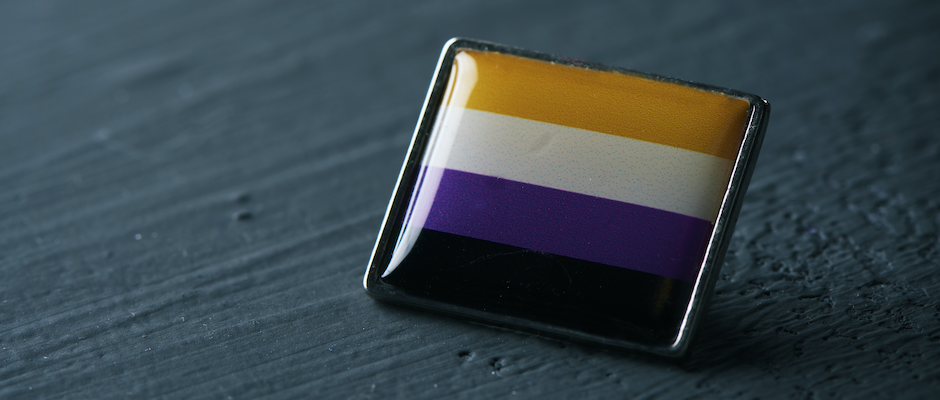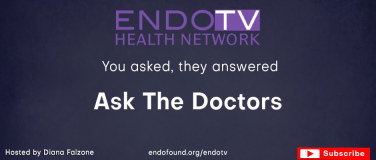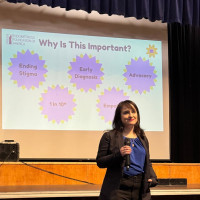
In many ways, Sam’s experience of diagnosis was similar to so many other endometriosis patients. In the years that they visited doctors to establish the cause of the chronic, debilitating pain they lived with on a daily basis, they sought the advice of three medical professionals and had to be their own biggest advocate for their health. This can be incredibly anxiety-inducing and wearing. However, Sam says that they feel their symptoms were questioned for another reason.
“I came out as non-binary in 2011. It became the total norm for me not only to have to really spell out the pain I was living with to doctors, but also to explain that someone who is masculine-presenting could even have endometriosis,” they say. “It often felt like clinicians took one look at me and it didn’t matter what I said. I didn’t match their idea of someone who could have endometriosis so the diagnosis was ruled out.”
It’s estimated that endometriosis impacts one in ten people who were assigned the label female at birth. However, due to many misconceptions within the medical community and wider society, it still takes an average of seven and a half years to be diagnosed. Studies have highlighted that non-binary and trans people are more likely to experience discrimination in a medical setting and are more likely to struggle to access medical services. Sam says they’ve experienced this first hand.
“The onus to prove my identity and the pain I was going through was put on me repeatedly. My condition has been explained to me time and time again in reference to the ‘female’ body, which isn’t something I identify with,” says Sam. “There’s so much about my body that I find difficult to talk about and face, yet my doctors seem to have no understanding of this. My body has felt like a mental and physical battleground for so long.”
Sam explains that from being misgendered in doctors appointments to tapping into a support network online, gendered language has meant they’ve felt excluded and alienated in their mission to get an endometriosis diagnosis.
Gendered language can be a barrier to diagnosis
The first time Sam remembers the pain that may be associated with endometriosis is just after their period had started when they were 13. During that time they were questioning their gender identity, and as their body changed, their feelings of gender dysphoria increased.
The NHS writes that gender dysphoria is a term that describes a sense of unease or distress “because of a mismatch between someone’s biological sex and their gender identity.”
“My period started a little later than all of my friends and I remember thinking at the time that it wasn’t something that was going to happen to me. It didn’t feel right in my body and as far as I was concerned it was something I could opt out of,” they say. “A few months after I had my first period, my chronic pain began. From that point onwards I associated my monthly bleed with feelings of shame and confusion as well as uncontrollable pain.”
As a teenager, Sam spoke to their doctor about this extreme pain and they say it was brushed off as period pain and they were recommended to take a few painkillers and rest up. “Going to my doctor to explain the pain I was going through was a big step, I was still pretty young and was scared,” they say. “But I think it was doubly hard because I was led to believe that the part of my body that was causing me trouble was something I already felt dysphoric about. I didn’t want to deal with it because it was already something that was causing me anxiety.”
Sam says that from this point they found it very difficult to attend doctors’ appointments and delayed attending them despite the fact that they’d missed school, weren’t seeing friends, and had put their romantic life on hold because the pain they were experiencing was too great.
The misconception that endometriosis is a condition exclusively experienced by women could be grounded in some of the first modern studies into the condition. John Sampson developed the theory that the condition was menstrual blood flowing back into the pelvis, causing severe pain. While the cause of endometriosis is still not clear, there’s still an underlying misconception that endometriosis is solely linked to the menstrual cycle and can only be experienced by women.
However, not all people born with a uterus are women and, by definition, endometriosis occurs outside of the uterus. By so tightly linking endometriosis to the female body, it can completely alienate trans and non-binary people who need medical help.
A turning point in Sam’s diagnosis
“Just before I left for college, my mum took me to see a new specialist doctor to try to establish what was happening. I’d already come out as non-binary and had been explicitly clear when setting up the appointment that my pronouns are they/them and that I experience gender dysphoria,” Sam says, “I felt hopeful about the appointment.”
However, as soon as they arrived at the surgery a nurse handed Sam a pamphlet that explained what ‘ladies’ with endometriosis go through. They were taken through to see the doctor who repeatedly used she/her pronouns and questioned why “a girl of your age” hadn’t been sent for endometriosis scans sooner.
“It was bittersweet. On the one hand, people were starting to take my pain and other symptoms seriously. On the other hand, the people who were supposed to be taking care of me completely disregarded my identity and who I am,” they explain. “Endometriosis felt like a big exclusive club for women that no one really wanted to be part of. But if you’re non-binary or gender non-conforming it’s almost as if you can’t own the title of your condition without educating everyone in the room that you still don’t identify as female.”
The New York Times writes that many medical schools only spend an average of five hours teaching students about LGBTQ+-specific care and practices. It could be because of this that many trans, non-binary, and gender non-conforming patients are left to educate their doctors about sexual identity. This may mean that they put off seeking medical help for endometriosis because the process is too anxiety-inducing and tiring.
When seeking a diagnosis for endometriosis, many experts recommend seeing a specialist doctor. However, Sam’s experience highlights that if you’re non-binary, seeing a specialist doesn’t always ensure that you receive the care that you need.
A community centered around gendered language
Studies have highlighted that endometriosis doesn’t just take a physical toll on your body. It’s been found that people with endometriosis are twice as likely to also experience depression. Having people around you who listen and understand what you’re going through can be a lifeline.
In one of their earliest appointments with their new specialist, Sam’s doctor recommended that they research support networks and organizations that advocate for people living with endometriosis. “I’d never met anyone else outside of doctors’ waiting rooms who has the condition,” they say. “I didn’t know anyone who lived with chronic pain. The idea that there may be people who completely understood what I’d been through really excited me.”
However, after joining the Facebook groups of a few endometriosis support pages, Sam was struck by how often endometriosis was described as a condition that only women struggled with. Many posts only addressed the “ladies” in the group. “It might not seem like a very big issue but after years of being told that endometriosis was a condition experienced exclusively by women, these groups reaffirmed that I didn’t belong. I couldn’t be part of the sisterhood,” says Sam.
Re-defining what it means to be an endometriosis patient
Some endometriosis advocacy groups are taking the steps to address the gendered language that has surrounded the condition for so many years. Endometriosis Network Canada produced an article entitled, “It's Time for the Endometriosis Community to Drop Gendered Language.”
They wrote, “When illness is gendered as endometriosis is, this creates significant barriers for trans [and non-binary] folks in need of support, information, or treatment. Not only do these barriers exist throughout the health-care system, but also in support groups and online forums that are often the only source of solace.”
It wasn’t until Sam tapped into a community of trans and non-binary endometriosis patients on Twitter that they could open up about their experience. “It feels sad to say that after years of sitting in doctors surgeries with experts and my loved ones, the first time I felt truly understood and listened to was when I reached out to strangers online,” they said, “They highlighted that while my experience wasn’t right at all, it also wasn’t uncommon.”
Sam delayed seeing an endometriosis specialist because they felt like the language surrounding the condition meant that they didn’t belong in the room. The gendered language surrounding endometriosis is dangerous for trans and non-binary patients. It can mean that people put off getting the medical help that they need and are faced with explaining their identity in appointments.
Advocating for your own health can be incredibly wearing. However, if you feel like your identity is questioned or ignored at every turn, it can be enough to stop people from seeking help in the first place.









